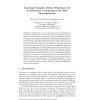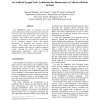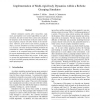649 search results - page 71 / 130 » Development of Control for a Serpentine Robot |
EWLR
1997
Springer
15 years 1 months ago
1997
Springer
Building robots can be a tough job because the designer has to predict the interactions between the robot and the environment as well as to deal with them. One solution to cope the...
110
click to vote
SASO
2008
IEEE
15 years 4 months ago
2008
IEEE
The SYMBRION project is concerned with the development of super-large swarms of robots that dock with each other and symbiotically share energy and computational resources to form...
IROS
2007
IEEE
15 years 4 months ago
2007
IEEE
— Robots’ interaction with humans raises new issues for geometrical reasoning where the humans must be taken explicitly into account. We claim that a human-aware motion system ...
HRI
2006
ACM
2006
ACM
Usability evaluation of an automated mission repair mechanism for mobile robot mission specification
15 years 3 months ago
This paper describes a usability study designed to assess ease of use, user satisfaction, and performance of a mobile robot mission specification system. The software under consid...
ICRA
2003
IEEE
15 years 3 months ago
2003
IEEE
Robotic simulation systems allow researchers, engineers, and students to test control algorithms in a safe environment, but until recently these systems only simulated the dynamic...



